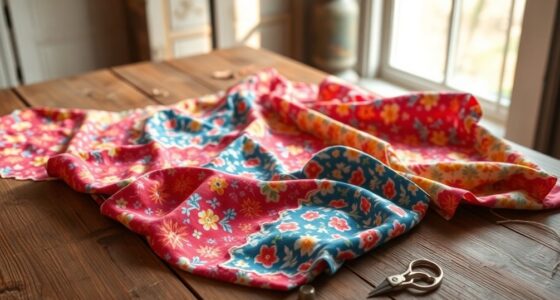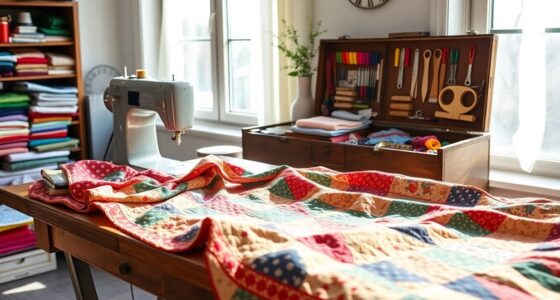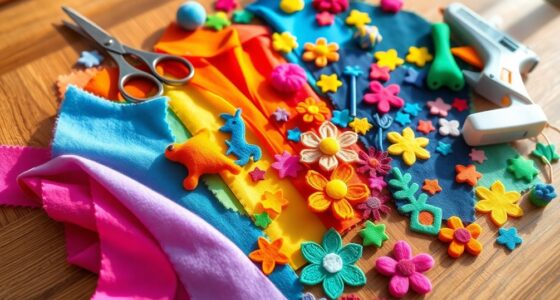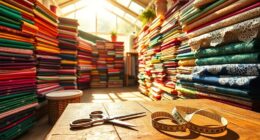Releasing your creativity through sewing is an exciting journey! Whether you're a beginner tackling your first tote bag or an advanced sewer perfecting tailored garments, there's a project for every skill level. Start with simple techniques to build confidence, then challenge yourself with zippers and embellishments. Experiment with fabrics and colors to make your creations unique. Get ready to explore personalized projects and join a supportive community where you can share and grow your craftsmanship.
Key Takeaways
- Start with beginner-friendly projects like tote bags and pillow covers to build confidence and foundational skills.
- Challenge yourself with intermediate projects involving zippers and buttonholes to refine your techniques and craftsmanship.
- Explore advanced techniques such as free motion quilting and tailoring to elevate your sewing skills and create polished garments.
- Personalize your projects using unique fabrics and custom embellishments for a distinctive touch that showcases your creativity.
- Join sewing communities for support, inspiration, and access to resources that enhance your skills at any level.
Discovering the Joy of Sewing
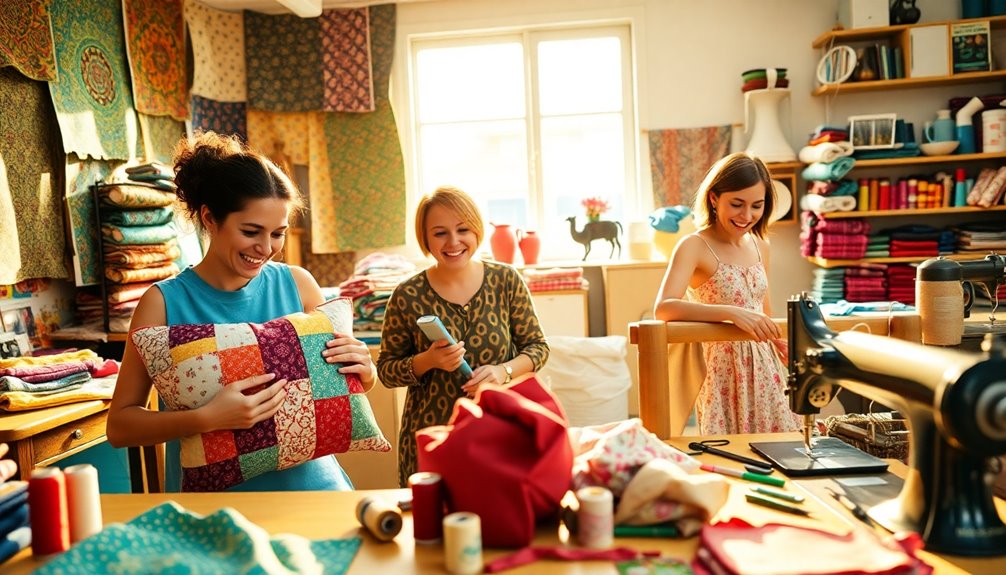
Sewing brings a unique joy that combines creativity and relaxation, making it a rewarding hobby for anyone.
You'll find that sewing provides a therapeutic outlet, letting you express your creativity while reducing stress and anxiety through hands-on projects.
As a beginner, you can easily access free online patterns that enhance your skills and encourage you to explore various techniques.
Each completed project fosters a sense of accomplishment, boosting your self-esteem and motivating you to tackle even more challenging creations.
Plus, the vibrant sewing community offers support and inspiration through forums and social media groups, where you can share your personal creations.
Sewing caters to all skill levels, ensuring you'll always find resources to help you grow and enjoy the craft.
Essential Tools for Your Sewing Journey
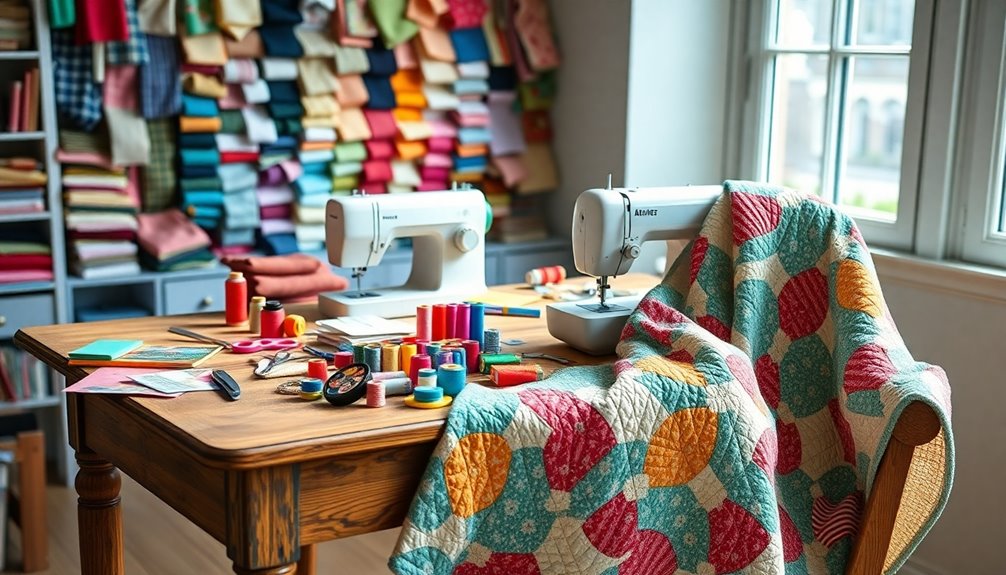
Starting on your sewing journey means having the right tools at your fingertips. A basic sewing kit should include fabric scissors, pins, a measuring tape, a seam ripper, and various needles for different fabrics. Investing in a quality sewing machine enhances your experience with adjustable stitch lengths and built-in patterns.
Using a rotary cutter and mat improves the accuracy of your cuts, while marking tools like tailor's chalk guarantee precise lines. Remember, maintaining your tools is vital—regularly replace dull blades and clean your sewing machine for the best results.
| Essential Tool | Purpose |
|---|---|
| Fabric Scissors | Cutting fabric cleanly |
| Pins | Holding pieces together |
| Measuring Tape | confirming accurate measurements |
| Seam Ripper | Undoing mistakes |
| Rotary Cutter | Precise and efficient cutting |
Beginner-Friendly Projects to Get Started
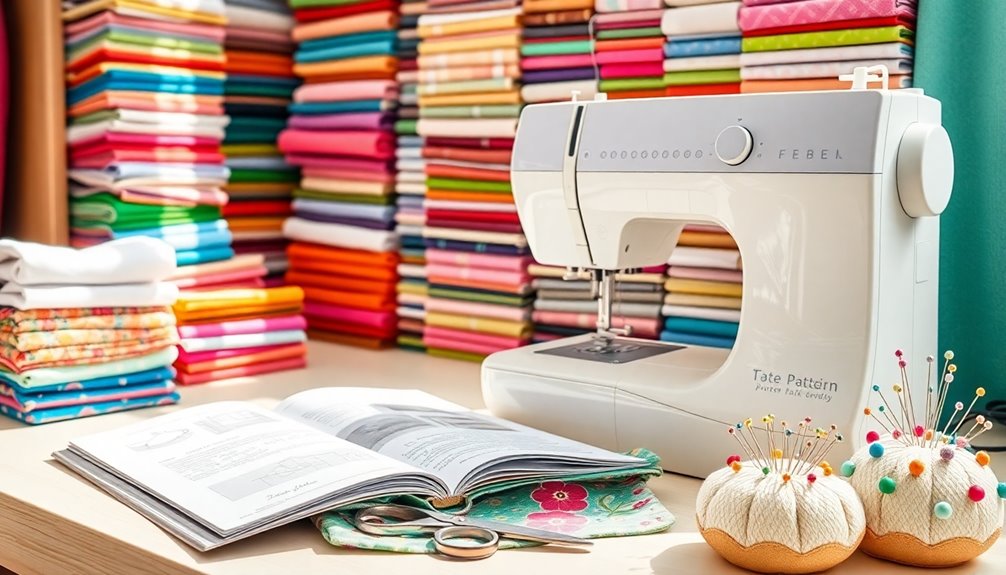
If you're new to sewing, starting with simple techniques can make a big difference in your confidence.
Quick projects like tote bags or pillow covers allow you to practice essential skills without feeling overwhelmed.
Plus, having the right tools on hand will set you up for success as you tackle these beginner-friendly creations. Engaging in beginner-friendly patterns can further enhance your sewing experience and boost your creativity.
Simple Sewing Techniques
While diving into the world of sewing might seem intimidating, mastering a few simple techniques can quickly set you on the path to creating beautiful projects.
Focus on foundational skills like:
- Straight stitching: This is your go-to stitch for nearly every project.
- Hemming: Perfect for finishing edges on garments or home decor.
- Using patterns: Downloadable patterns simplify the process and guide your creations.
Quick Project Ideas
Once you've grasped the fundamental techniques, it's time to put them into action with some quick and beginner-friendly projects. These projects are perfect for practicing basic skills while keeping things fun and manageable. You can create items like tote bags, pillow covers, or simple skirts, using straight lines and easy patterns. Here's a quick reference table to spark your creativity:
| Project | Materials Needed | Estimated Time |
|---|---|---|
| Tote Bag | Fabric, handles | 1-2 hours |
| Pillow Cover | Fabric, pillow insert | 1 hour |
| Simple Skirt | Fabric, elastic | 2 hours |
| Fabric Coasters | Fabric, batting | 1 hour |
| Headband | Fabric, elastic | 30 minutes |
These projects encourage experimentation without breaking the bank!
Essential Tools Needed
Having the right tools can make all the difference in your sewing journey, especially when starting out. Investing in essential tools will set you up for success and make your projects more enjoyable.
Here are a few must-haves:
- Fabric scissors: A quality pair guarantees clean cuts and works well with various materials.
- Sewing machine: A reliable machine with basic stitches simplifies your sewing process and opens the door to many beginner-friendly projects.
- Measuring tools: A tape measure and ruler are vital for achieving precise dimensions, giving your projects a professional finish.
Don't forget a seam ripper for correcting mistakes easily!
With these tools in hand, you'll be ready to release your creativity and tackle your first sewing projects.
Intermediate Challenges to Enhance Your Skills
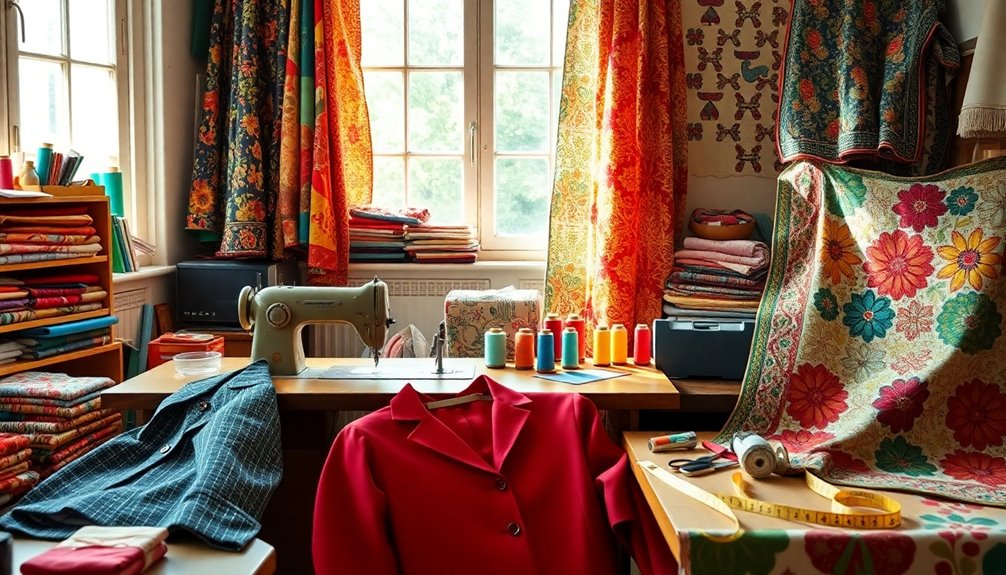
As you plunge into intermediate sewing projects, you'll discover that tackling techniques like installing zippers and creating buttonholes not only enhances your skill set but also boosts your confidence. You'll explore more complex patterns that feature linings, tailored finishes, and details like pockets, collars, and cuffs. These projects help refine your accuracy and craftsmanship. Plus, utilizing online resources like downloadable patterns and tutorial videos can make these techniques more accessible.
| Technique | Benefit |
|---|---|
| Installing Zippers | Improves garment functionality |
| Creating Buttonholes | Elevates your project's professional look |
| Working with Non-Stretch Fabrics | Enhances fabric handling skills |
Engaging in sewing communities can also provide valuable support and feedback.
Advanced Techniques for Seasoned Sewers
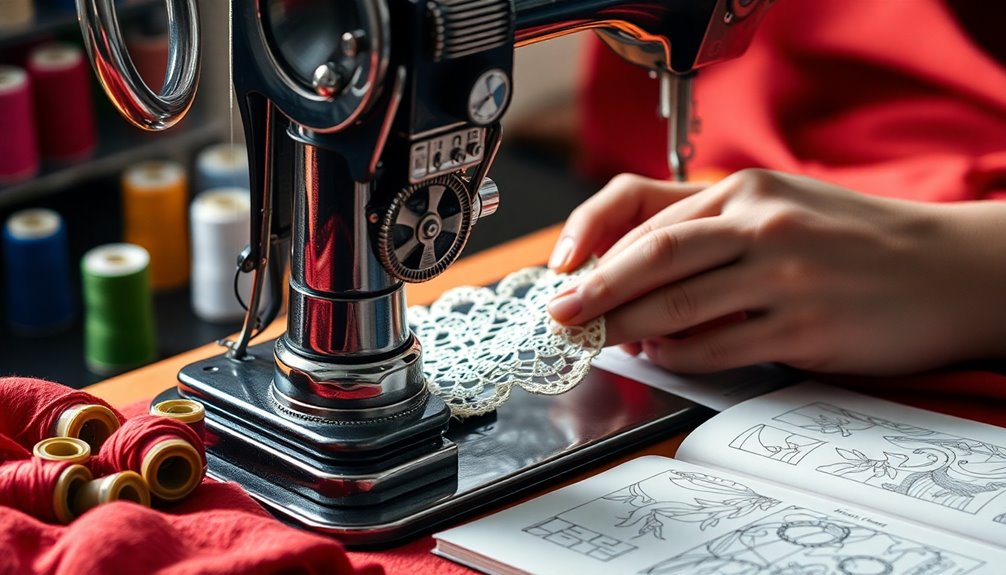
As a seasoned sewer, you're ready to explore innovative stitching methods that can elevate your projects.
Enhancing your tailoring skills opens up new possibilities for creating garments with impeccable finishes and custom fits.
Let's look at techniques that push your sewing to the next level.
Innovative Stitching Methods
While you may already have a solid foundation in sewing, exploring innovative stitching methods can take your skills to the next level. Techniques like free motion quilting and reverse appliqué let you experiment with texture and design, while methods such as pintucking and smocking add dimension and sophistication to your projects.
Consider incorporating these methods into your sewing repertoire:
- Heirloom sewing for intricate details
- Bias binding for professional finishes
- Fabric manipulation to create custom pieces
Utilizing specialized tools like walking feet and stitch-in-the-ditch feet also enhances your precision, allowing for more innovative designs.
Embrace these techniques, and watch as your sewing transforms into a mesmerizing art form!
Tailoring Skills Enhancement
To elevate your sewing game, mastering advanced tailoring techniques is essential for creating garments that look polished and fit perfectly. Techniques like flat-felled seams and welt pockets enhance durability while providing a refined appearance. Don't forget to focus on fitting adjustments, such as altering darts and shoulder seams, for that ideal fit. Underlining and interfacing improve your garments' structure and longevity, ensuring a professional finish. Using specialized tools like a tailor's ham and sleeve board allows for precise pressing and shaping.
| Technique | Purpose | Tools Needed |
|---|---|---|
| Flat-Felled Seams | Enhance durability and finish | Sewing machine, iron |
| Welt Pockets | Create refined pocket openings | Pocket template, fabric |
| Fitting Adjustments | Achieve perfect fit | Measuring tape, pins |
| Underlining | Improve garment structure | Underlining fabric |
Exploring Different Fabrics and Materials
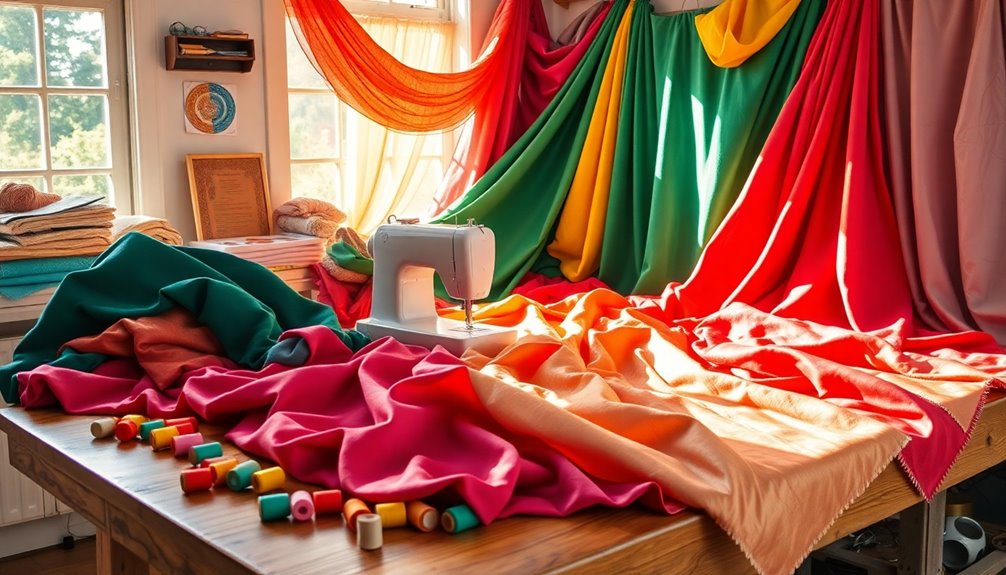
When you plunge into the domain of sewing, exploring different fabrics and materials opens up a sphere of possibilities for your projects. Each fabric has unique properties that affect how it behaves when sewn, from drape to durability.
Understanding fabric weight is essential; heavier materials like canvas may need different needle sizes compared to lighter options like chiffon.
Consider these aspects when choosing your fabric:
- Cotton: Versatile and easy to work with, great for beginners.
- Linen: Breathable and perfect for summer garments, but can be tricky to sew.
- Knit: Adds comfort and fit, but requires specific techniques to handle its stretch.
Experimenting with various textiles enhances your creativity and influences the final look of your work.
Tips for Personalizing Your Sewing Projects
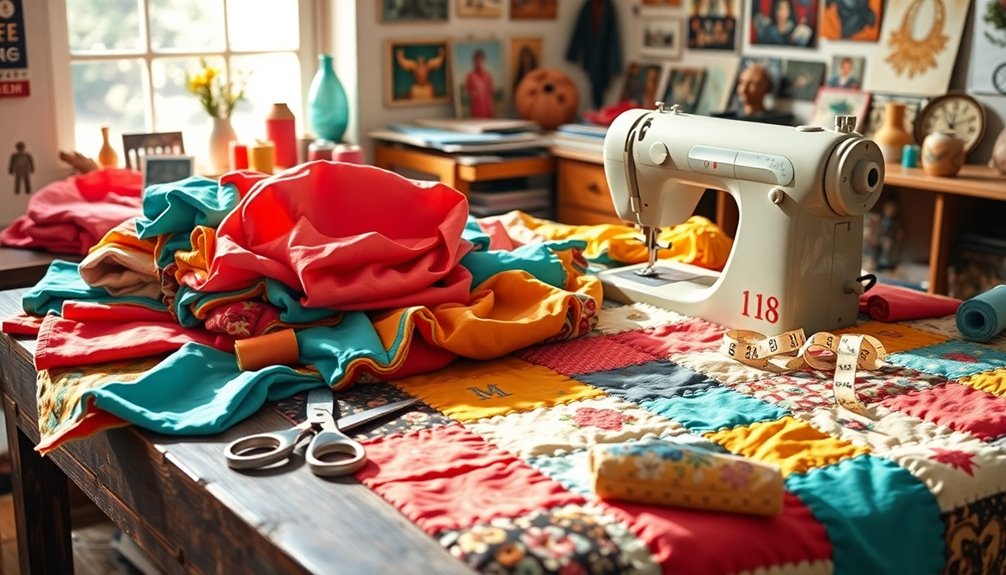
Personalizing your sewing projects can really elevate your creations.
You can choose unique fabrics, add custom embellishments, or modify patterns to reflect your style.
These simple changes can make your work truly one-of-a-kind and showcase your personality.
Choose Unique Fabrics
Choosing unique fabrics can transform your sewing projects from ordinary to extraordinary, allowing your personal style to shine through. By selecting bold prints or textured materials, you'll elevate the visual appeal and create one-of-a-kind pieces that reflect your creativity.
Here are some tips to take into account:
- Experiment with color combinations and patterns for a standout look.
- Incorporate specialty fabrics like denim or velvet to add depth and interest.
- Mix and match fabric types, such as cotton with lace, to create striking contrasts.
Personalizing your projects with unique fabrics not only enhances their uniqueness but also makes the sewing process more enjoyable.
Plus, you'll likely receive positive feedback, making your efforts even more rewarding!
Add Custom Embellishments
Adding custom embellishments can greatly enhance your sewing projects, making them truly one-of-a-kind. You can personalize your creations with techniques like embroidery, appliqué, or fabric paint to reflect your unique style.
Using contrasting thread colors for stitching adds visual interest and elevates your designs. Consider incorporating buttons, beads, or sequins to introduce texture and dimension, transforming a simple piece into a standout item.
Patches or badges not only allow creative expression but also help cover any sewing imperfections.
Don't hesitate to experiment with different embellishment techniques; this practice will boost your sewing skills and inspire fresh project ideas, no matter your experience level.
Let your creativity shine through your personalized touches!
Modify Patterns Creatively
Once you've enhanced your projects with custom embellishments, consider taking the next step by modifying patterns creatively. Start by analyzing the original pattern to pinpoint areas that can be altered, like length or style lines. This allows you to make adjustments that truly reflect your taste.
Here are some tips to guide you:
- Experiment with different fabrics and textures to dramatically change the overall look.
- Incorporate unique embellishments, such as pockets or appliqués, for added interest.
- Use a muslin or mock-up before cutting into your final fabric, ensuring you can make fitting adjustments seamlessly.
Don't forget to document your modifications and any challenges; this will sharpen your skills and serve as a handy reference for future projects. Additionally, consider using mood boards to visualize your design ideas and stay inspired throughout the process.
How to Organize Your Sewing Space

Organizing your sewing space can transform your creative experience and boost productivity, making it easier to tackle projects with confidence.
Start by decluttering your area; remove items you no longer use. This creates a more efficient environment.
Use clear storage bins and labels to categorize fabrics, threads, and tools, so you can easily find what you need.
Designate specific areas for cutting, sewing, and storing materials to streamline your workflow and prevent mixing supplies.
Incorporate vertical storage solutions like pegboards or wall-mounted shelves to maximize space and keep frequently used items accessible.
Finally, regularly reassess and reorganize your sewing space to adapt to your project needs, ensuring it remains a creative and inspiring environment.
Joining the Sewing Community: Tips and Resources
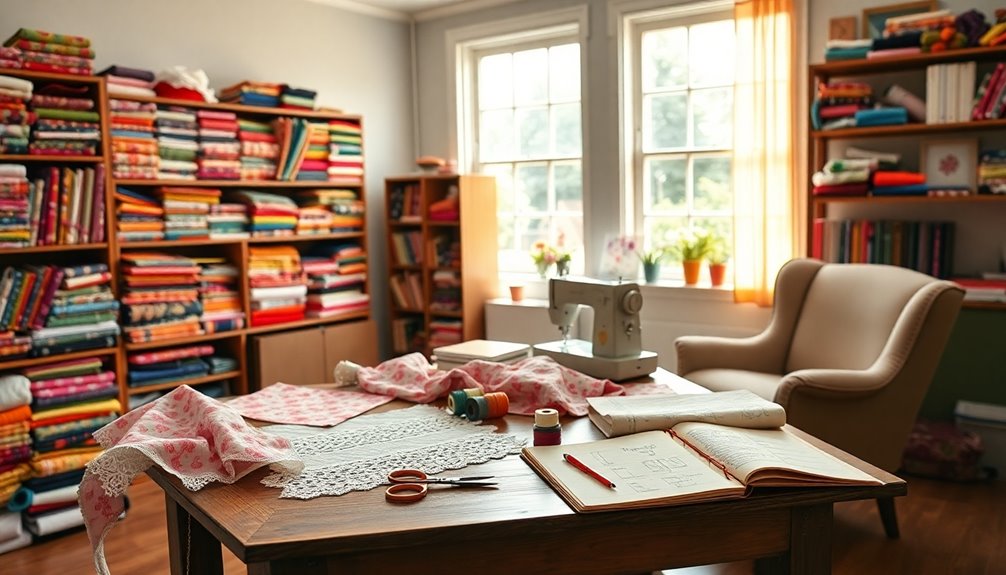
Creating a well-organized sewing space sets the stage for your creative journey, but connecting with others in the sewing community can take your skills to the next level.
Joining online forums and social media groups can provide support, inspiration, and valuable tips from fellow enthusiasts.
Consider these options:
- Participate in local sewing clubs or workshops for hands-on guidance.
- Explore downloadable patterns and resources shared within the community.
- Engage with video tutorials to boost your understanding and confidence.
Showcasing Your Creations: From Sharing to Selling
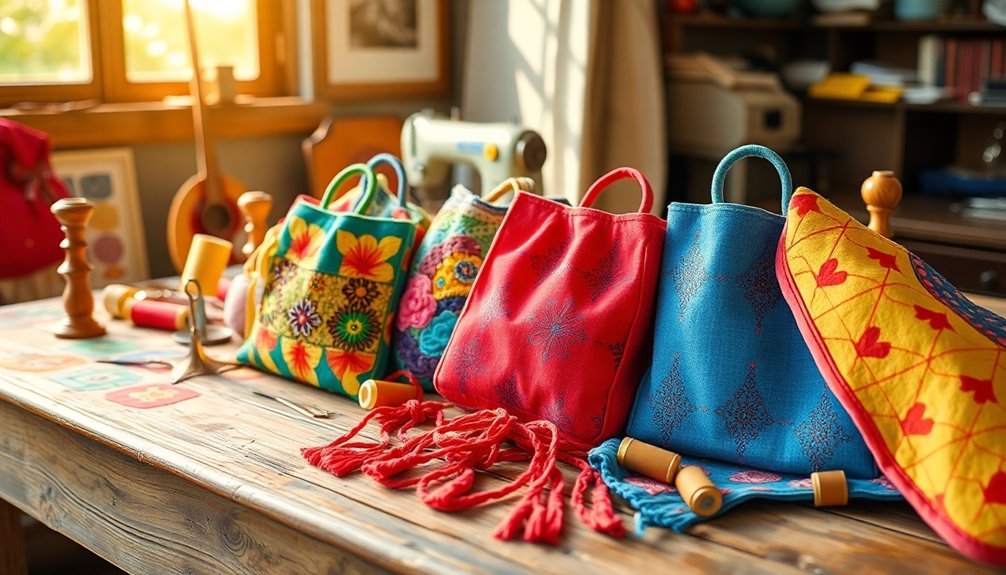
How can you effectively showcase your sewing creations to a wider audience? Start by sharing your work on social media platforms. This not only helps you connect with fellow creators but also offers valuable feedback to enhance your skills.
Consider creating an online shop on platforms like Etsy or Shopify to sell your handmade items globally, expanding your reach beyond local markets. Make sure to use high-quality photos and detailed descriptions to attract buyers and highlight the uniqueness of your work.
Engage with customers through personalized messages and prompt responses to inquiries, fostering loyalty and encouraging repeat purchases. Additionally, be sure to emphasize the color accuracy of your creations in your descriptions, as it can greatly impact buyer interest.
Finally, participate in local craft fairs to showcase your creations, gather feedback, and connect directly with potential customers.
Frequently Asked Questions
What Is the Best Beginner Sewing Project?
If you're starting out in sewing, a simple tote bag is one of the best beginner projects. It requires just a few basic skills and minimal materials, making it practical and achievable.
You can also try making pillow covers, which allows you to experiment with different fabrics and patterns. A drawstring bag is another great option that helps you learn essential techniques, while an elastic waist skirt can boost your garment construction skills.
What Is the Most Popular Thing to Sew?
Sewing's like painting a blank canvas; it lets you express your style. The most popular things to sew are clothing items like skirts and dresses, which showcase your creativity and personal flair.
Home decor projects, such as pillow covers, also rank high for their practicality. Plus, accessories like bags or wallets have gained traction for their versatility.
Don't forget quilting, a beloved project that brings people together through shared techniques and patterns.
What Can I Sew in 30 Minutes?
You can sew several quick projects in just 30 minutes! Consider making simple pillow covers, tote bags, or fabric bookmarks.
Using pre-cut fabric or straightforward patterns speeds up your work. Master basic techniques like straight stitching and hemming, which are easy to learn.
There are plenty of online resources, like video tutorials, that guide you through each step. Completing these projects will give you a sense of accomplishment and inspire you to tackle more challenging items.
What Is the Easiest Thing to Make With Fabric?
Did you know that nearly 70% of beginner sewists start with simple projects?
If you're looking for the easiest thing to make with fabric, a pillowcase is your best bet. It requires just a few straight seams and minimal skills.
You might also try fabric bookmarks or tote bags, which are straightforward and allow for personal touches.
Whichever project you choose, you'll gain confidence and have fun while creating something useful!
Conclusion
Sewing isn't just a craft; it's a journey of self-expression and creativity. Whether you're stitching your first hem or crafting intricate designs, each project offers a chance to learn and grow. Research shows that engaging in creative activities like sewing can boost your mood and enhance problem-solving skills. So, why not immerse yourself? Embrace the process, share your creations, and connect with fellow enthusiasts. You might just discover a passion that transforms your life in unexpected ways!


